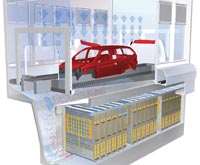More Productive Painting
Electrostatic separation cuts costs, energy use, environmental impact.
#energy #pollution control #sustainability
Continuous improvements in efficiency and quality, reduced energy consumption, minimized emissions—these are the metrics by which the success of automotive and other high-volume paint shops are measured.
Featured Content
Paint system supplier Eisenmann Corporation (Crystal Lake, IL) says its newly developed electrostatic separation system for paint overspray can help painters achieve their productivity and conservation goals by reducing waste, cutting operating costs and minimizing environmental impact.
The E-Scrub system directs air in the spray booth so that surplus paint mist (overspray) produced during painting is routed via funnel-shaped run-off surfaces known as flood sheets into a new electrostatic separation system. Part of the overspray is immediately bound using a separating agent on the flood sheets, while the bulk of the paint material continues through the electrostatic separation portion of the system.
The separation process begins in “separating modules” at the bottom of the flood sheets. The high-voltage modules are fitted with positively charged separating plates which are also rinsed with separating agent in a circulating system. High-voltage wires also run horizontally between the separating plates inside the module. Paint particles in the circulating air stream become negatively charged as they pass near the high-voltage wires and are attracted by the positively charged separating plates. They are then bound by the separating agent and discharged into a bottom-mounted collecting pan. According to Eisenmann, the chemical composition of the separating agent causes bound paint particles to combine in the collecting pan and form solid agglomerates, which can then be removed and disposed of without difficulty.
The company says electrostatic charging of paint overspray particles and binding of overspray in the separating agent maximizes collection efficiency, enabling the system to meet stringent air quality requirements. The German clean air regulation “Technical Instructions on Air Quality Control” (commonly known as TA Luft), for example, permits maximum dust emissions of 3 mg/m3. According to Eisenmann, the E-Scrub system can cut emissions to well below the regulation, to 0.3 mg/m3.
The system operates with 95% recirculated air. Eisenmann says this results in energy savings of up to 78% compared with conventional wet scrubber technology, as well as an 87% reduction in water usage and considerably reduced chemicals usage. The electrostatic system switches on and off in accordance with production, yielding further energy savings.
Electrostatic paint overspray separation improves paint quality by eliminating complex mechanical filtration systems and ensuring constant flow rates without pressure fluctuations, Eisenmann says. The system is also said to be considerably quieter and easier to service than mechanical systems, with fewer components than conventional wet scrubber systems. It can be retrofitted quickly and simply in existing paint plants.
RELATED CONTENT
-
Expanding on E-Coat
Electrocoat products and processes continue to evolve, with development focused on lower energy use, very low VOC content and methods to reduce cost per applied square foot. The following is a primer on how a combination of new materials and good process control can be used to achieve the highest possible efficiency.
-
Putting a Lid on Tanks
KCH Engineered Systems says tank covers reduce overall exhaust requirements, fugitive emissions, heat loss and evaporation rates, energy consumption and calculated surface area for exhaust rates.
-
Pretreatments: The Next Generation
Emerging technologies can save energy, ease environmental concerns




















